44 F. high temperature on Tuesday in the Twin Cities.
40 F. normal high for March 15.
60 F. high temperature reported on March 15, 2010.
5" snow on the ground in the Twin Cities.
6 days/row above 32 F. Temperatures should stay above freezing (consistently) from Wednesday morning through at least Tuesday evening of next week, accelerating snow melt, and possibly speeding up run-off and subsequent flooding over the next 2-3 weeks.
Light showers: Thursday, again Sunday. Potentially heavier rain by next Tuesday.
Flood Watch issued for the Jackson/Windom area of far southwestern Minnesota.
"Ariana": name of the new tropical storm off the coast of Brazil. Highly unusual for mid March in the South Atlantic.
_______________________________________________________________
* Is Japan's nuclear situation out of control? U.S. media may be taking an overly optimistic look at the disaster - as difficult as that may be to believe. Details
here.
* "Run Faster!" escaping a tsunami by mere inches...
* California stocking up on iodide tablets, just in case. Details in the blog.
Level 7? Yesterday, André-Claude Lacoste, president of France's national organization for nuclear safety, said that
the level threat should be 5 and perhaps 6. Today, the French energy agency said that this disaster is only second to Chernobyl and has recommended to raise the alert to 7, the maximum in the nuclear event scale. France has 58 operating reactors, only second to the United States' 104. The complete story in Gizmodo is
here.
Flood Watch. The National Weather Service has issued a flood watch for portions of the Dakotas and the Jackson/Windom area of far southwestern Minnesota, where flooding may be imminent within the next 2-3 days. Get the latest watches and warnings for the nation
here.
...THE NATIONAL WEATHER SERVICE IN SIOUX FALLS HAS ISSUED A FLOOD
WATCH FOR THE FOLLOWING RIVERS IN SOUTH DAKOTA...IOWA...MINNESOTA...
JAMES RIVER AT HURON
JAMES RIVER NEAR FORESTBURG
JAMES RIVER AT MITCHELL
JAMES RIVER NEAR SCOTLAND
JAMES RIVER ABOVE YANKTON
VERMILLION RIVER NEAR DAVIS
VERMILLION RIVER NEAR WAKONDA
BIG SIOUX RIVER NEAR BROOKINGS
BIG SIOUX RIVER NEAR DELL RAPIDS
BIG SIOUX RIVER AT SIOUX FALLS 60TH STREET
BIG SIOUX RIVER AT SIOUX FALLS NORTH CLIFF
BIG SIOUX RIVER AT HAWARDEN
BIG SIOUX RIVER AT AKRON
SPLIT ROCK CREEK NEAR CORSON
ROCK RIVER AT ROCK RAPIDS
LITTLE SIOUX RIVER AT SPENCER
LITTLE SIOUX RIVER AT LINN GROVE
DES MOINES RIVER AT JACKSON
.THE FOLLOWING RIVER FORECASTS ONLY INCLUDE FORECAST PRECIPITATION
THROUGH THIS AFTERNOON AND ARE PRIMARILY DRIVEN BY SNOWMELT. ANY
ADDITIONAL FUTURE RAINS COULD AFFECT THE CREST FORECASTS.
WARM TEMPERATURES ARE EXPECTED TO CONTINUE ACROSS THE REGION FOR THE
NEXT 10 TO 14 DAYS. HIGHS WILL BE IN THE 40S AND 50S FOR MOST AREAS
WITH SOME 60S POSSIBLE. OVERNIGHT LOWS WILL BE IN THE MID 20S TO
LOWER 40S THROUGH THE PERIOD...WHICH WILL MEAN THAT THERE WILL BE
FEW HOURS WHERE THE MELTING PROCESS WILL STOP. THE SNOW PACK ACROSS
THE REGION WILL BE RAPIDLY MELTING THROUGH THIS WEEKEND WHICH WILL
LEAD TO RAPID RISES ON THE AREA RIVERS AND STREAMS. THERE IS ALSO
STILL CONSIDERABLE ICE ON THE RIVERS AND STREAMS NORTH OF INTERSTATE
90...AND ANY ICE JAMS THAT COULD DEVELOP WILL AFFECT THE CREST
FORECASTS.

. It looks like we may catch a bit of an atmospheric break, at least looking out the next 5 days or so. The models print out about .10" rain on Thursday, and maybe .10 to .20" rain on Sunday (considerably less than the previous runs). The GFS is suggesting a more significant rain/snow event by Tuesday of next week as a more impressive Pacific storm approaches from the southwest. Again, the GFS has been more unreliable than usual in recent weeks - hopefully the Tuesday storm will not materialize.
Good News. Here are the latest rainfall predictions - a fast moving system may squeeze out a tenth of an inch Thursday, slightly more on Sunday, with more substantial rain by Tuesday of next week. Temperatures at 850 mb (about 3,500 feet above the ground) are forecast to be near 32 F. by Tuesday, meaning a possibility of a rain/snow mix next week. Yep, still a little early to retire the snow shovels.
Sunday Evening. The 00z Tuesday GFS run shows a moist, southerly fetch Sunday evening, sparking scattered showers, but the heaviest rainfall amounts (bright green) are forecast to stay north/east of Minnesota over the weekend. The scenario still makes me nervous - it wouldn't take much for future runs to print out more significant rainfall amounts on Sunday - something we need to watch.
Tuesday Evening. It's worth repeating: anything beyond 48-72 hours is more of a "trend" than a "forecast". I hope this solution is wrong - the GFS HAS been highly unreliable over the last 2 weeks (Exhibit A: last week's snowfall bust). The GFS prints out a fairly impressive Pacific storm over Nebraska by Tuesday evening, throwing down a shield of moderate rain from the Dakotas to the Great Lakes. If this verifies rainfall amounts could easily top .50", with some 1" amounts possible close to home. The rain/snow line may be very close to MSP by Tuesday night - I wouldn't be at all surprised to see some wet snow falling from next week's system, especially over central and northern Minnesota. It's too early to say with any confidence.
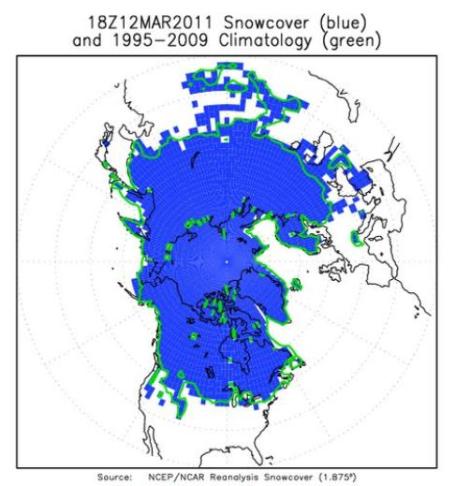
Snowcover Over The Northern Hemisphere Remains Well Above Average. According to an
article at New York City weather start-up, WeatherBell, there's still more snow on the ground across North America and Asia than usual by mid March: "The snowcover for the northern hemisphere is tracked by FSU’s Bob Hart
here. An anomaly relative to the 1995-2009 climatology is shown. For the second winter in a row and 3rd in 4 years, the snowcover was above normal. Last year snowcover diminished at the start of March but this year, it remains well above the normal."
Is Japan's Nuclear Situation "Out Of Control"? Some nuclear experts in Europe believe that U.S. and Japanese media is being too optimistic (if you can believe that). Helicopters dropping water on reactors from above is probably not a good sign. From what I understand the greater (overall) risk is the spent fuel rods in the holding ponds, which can spontaneously combust if they overheat - the fact that they're trying to pour sea water onto the reactor and fuel rods means they've essentially written off these reactors. Salt water is corrosive - no way to (easily) get these reactors back into operation anytime soon. A harrowing
story from Gizmodo: "
The European Union's energy commissioner Guenther Oettinger said today that the Japanese nuclear disaster is a lot worse than what Japan is declaring. In fact, he believes it could be an apocalypse:
There is talk of an apocalypse and I think the word is particularly well chosen [...] I hope that it doesn't happen, but we can't rule out that the worst case scenario [a complete meltdown a la Chernobyl] happens in the next few hours or days.
The European view on the subject is way darker than what the IAEA, the Japan government and most of the United States' media is portraying. Oettinger said that the situation is "almost completely out of control" and that it's only going to get worse as workers get evacuated. Nuclear emergency experts believe that you can't keep the situation from escalating without enough personnel on site, pointing at the 50 engineers now at the nuclear complex. Spanish radiobiology scientist Eduard Rodríguez-Farré says that Fukushima is like a "slow-motion camera Chernobyl". According to him, the situation is now "running wild."
"Run Faster!" Staying Inches Ahead Of An Advancing Tsunami. The video and photos coming out of Japan have been heartbreaking, at times remarkable, CNN has become a 24/7 horror movie-come-to-life. And along comes this
video clip from Mediaite: "
A new amateur video obtained by Al Jazeera English shows residents in the Japanese town of Minamisanriku as they ran to safety ahead of the tsunami which devastated their town. In the video, a group of people is seen trying to carry someone to safety as the water rushes toward them. People on a nearby hillside shout at them, “run faster!” As Al Jazeera’s Caroline Malone reports, the waters overwhelmed the town “houses, people, everything.” The group running ahead of the rising waters ultimately escape, Malone says, “but only just.” The video of their escape–complete with people screaming amid the sound of the powerful water–is chilling."
Japanese Left Homeless By Tsunami Facing Radiation Fears. I can't think of anything much worse than this: your home floats away, now you're stuck in a homeless shelter, yet that shelter may be in the path of radioactive fallout from nearby nuclear plants. A
video from the BBC: "In the city of Sendai, survivors of Friday's earthquake and tsunami are not only having to cope with the aftershocks, but also fear exposure to radiation. The disaster devastated Japan's north-east coast, with more than 3,000 confirmed dead and thousands missing. Radiation levels have now fallen at Japan's earthquake-stricken Fukushima Daiichi nuclear plant, located 60 miles from Sendai, but concerns remain after they earlier spiked to harmful levels. The BBC's Damian Grammaticas has been speaking to people in the area.
Surgeon General: Buying Iodide A "Precaution". People (worldwide) are understandably nervous about the implications for a full-scale nuclear meltdown in Japan, and subsequent radioactive fall-out. The reality: although a grave concern within a few hundred miles of the reactor(s) the vast majority of any radioactive particles would settle out (via rain) long before reaching Minnesota. Even so, some residents on the west coast are taking precautions, as
reported by NBC in the Bay Area: "
The fear that a nuclear cloud could float from the shores of Japan to the shores of California has some people making a run on iodine tablets. Pharmacists across California report being flooded with requests. State and county officials spent much of Tuesday trying to keep people calm by saying that getting the pills wasn't necessary, but then the United States surgeon general supported the idea as a worthy "precaution." U.S. Surgeon General Regina Benjamin is in the Bay Area touring a peninsula hospital. NBC Bay Area reporter Damian Trujillo asked her about the run on tablets and Dr. Benjamin said although she wasn't aware of people stocking up, she did not think that would be an overreaction. She said it was right to be prepared."
Tropical Storm In March - Off The Coast of Brazil? Yes - very odd to be tracking a true tropical, warm-core system in mid March, evidence of unusually warm water in the South Atlantic (which experienced its first hurricane on record back in 2005 off the coast of Brazil - previously meteorologists thought the South Atlantic ocean water was too cool to support hurricane formation). "Arani" is expected to remain out at sea, probably not a threat to coastal Brazil.
More from NASA: "NASA's Aqua satellite spotted some strong convection in a recently formed low pressure area that strengthened into Sub-Tropical Storm Arani in the South Atlantic. Arani formed near the coast of Brazil and is now moving away from it. Tropical cyclones in the Atlantic are a rare occurrence and since 2004 there have only been three of them, Arani being the third. On March 14, 2011 at 1553 UTC (11:53 a.m. EST) the Atmospheric Infrared Sounder (AIRS) instrument that flies aboard NASA's Aqua satellite captured an infrared image of Sub-Tropical Storm Arani moving away from the Brazilian coast. Most of the convection and thunderstorms were limited to the eastern half of the storm at the time of the image. The strong areas of convection (rapidly rising air that condenses and forms the thunderstorms that power a tropical cyclone) appeared on the imagery as a sideways boomerang, and were off-shore, paralleling the coast.

. We've all become our own "news directors", sipping on tweets, FB posts, links and e-mails throughout the day. Here's a fascinating
summary of the state of the media in 2011, from the Pew Project For Excellence In Journalism: "
As of the end of 2010, more people get their news from the Internet than from newspapers — and more ad dollars went to online outlets than to newspapers, too. In surveys conducted by the Pew Project for Excellence in Journalism, 34% of respondents said they read news online within the past 24 hours (as opposed to 31% who favored newspapers); and a full 41% said they get most of their news online, 10% more than those who said they got most of their news from a newspaper. Of course, the 18-to-29-year-old group overwhelmingly cast their vote with the web; 65% said the Internet was their main news source."
State Of The News Media - 2011. The Pew Project For Excellence In Journalism has a fascinating snapshot of the current state of the media - and where things seem to be going. More people becoming their own "news directors", hunting out news from their favorite online sources, Facebook, Twitter - mobile devices. The landscape has changed dramatically in just the last 5-7 years. Here's an excerpt from the
report: "
By several measures, the state of the American news media improved in 2010. After two dreadful years, most sectors of the industry saw revenue begin to recover. With some notable exceptions, cutbacks in newsrooms eased. And while still more talk than action, some experiments with new revenue models began to show signs of blossoming. Among the major sectors, only newspapers suffered continued revenue declines last year—an unmistakable sign that the structural economic problems facing newspapers are more severe than those of other media. When the final tallies are in, we estimate 1,000 to 1,500 more newsroom jobs will have been lost—meaning newspaper newsrooms are 30% smaller than in 2000. Beneath all this, however, a more fundamental challenge to journalism became clearer in the last year. The biggest issue ahead may not be lack of audience or even lack of new revenue experiments. It may be that in the digital realm the news industry is no longer in control of its own future. News organizations—old and new—still produce most of the content audiences consume. But each technological advance has added a new layer of complexity—and a new set of players—in connecting that content to consumers and advertisers. In the digital space, the organizations that produce the news increasingly rely on independent networks to sell their ads. They depend on aggregators (such as Google) and social networks (such as Facebook) to bring them a substantial portion of their audience. And now, as news consumption becomes more mobile, news companies must follow the rules of device makers (such as Apple) and software developers (Google again) to deliver their content. Each new platform often requires a new software program. And the new players take a share of the revenue and in many cases also control the audience data."
The Internet Is Over. When the 'net becomes ubiquitous - when every device is a "smart", connected device, all communicating with each other - will we still be accessing the Internet (or will it be accessing us?) Too deep for a Wednesday, sorry. But if you want to think big, expansive thoughts about the future of communications and the darker side of the Internet, the U.K. Guardian has a thought-provoking
article: "
We've been hearing about this moment in digital history since at least 1988, when the Xerox technologist Mark Weiser coined the term "ubiquitous computing", referring to the point at which devices and systems would become so numerous and pervasive that "technology recedes into the background of our lives". (To be fair, Weiser also called this "the age of calm technology", implying a serenity that the caffeinated, Twitter-distracted masses in Austin this week didn't seem yet to have attained.) And it's almost a decade since annoying tech-marketing types started using "mobile" as an abstract noun, referring to the end of computing as a desktop-only affair. But the arrival of the truly ubiquitous internet is something new, with implications both thrilling and sinister – and it has a way of rendering many of the questions we've been asking about technology in recent years almost meaningless. Did social media cause the recent Arab uprisings? Is the web distracting us from living? Are online friendships as rich as those offline? When the lines between reality and virtuality dissolve, both sides of such debates are left looking oddly anachronistic. Here, then, is a short tour of where we might be headed instead."
Bon Jovi: Apple's Steven Jobs In Personally Responsible For Killing The Music Industry. Hmm. Seems like a bit of a stretch to me. Jobs (and iTunes) made it easy to download individual tracks, instead of spending $8-15 for an album or CD with only 1 or 2 good singles on it. That, and the quality of the mp3's we all have on our gadgets isn't nearly as good as the sound you get from vinyl and some really good speakers. Can't argue with that. If you really care, Huffington Post has the
details: "
You can download Bon Jovi songs on iTunes, but don't expect the band to be too happy about it. Rocker Jon Bon Jovi, whose band soared to prominence with its 1986 album Slippery When Wet, reminisced in the Sunday Times Magazine about his days as a kid in New Jersey, falling in love with music -- and ripped Apple CEO Steve Jobs for taking that opportunity away from a new generation of listeners. "Kids today have missed the whole experience of putting the headphones on, turning it up to 10, holding the jacket, closing their eyes and getting lost in an album; and the beauty of taking your allowance money and making a decision based on the jacket, not knowing what the record sounded like, and looking at a couple of still pictures and imagining it," he said (via MSN), thinking back to his record buying days. Then came the less fanciful: the blame."
Six Beloved Scientists Who Were Actually Total Jerks. Subjective? Yes, probably. The same list of scientific luminaries who inspired the world (including Thomas Edison, Ben Franklin and Aristotle) were obviously brilliant, dedicated and tenacious. They were also (apparently) pretty hard to work with - and live with. Blastr.com has all the
details: "
When you've spent your life as a famous scientist, historians tend to forget your bad personality traits. It makes sense: If you're out there curing the black plague, who really cares if you have a problem with skin fungus or hookers (or both)? Despite this, the six scientists in this article were such abominable jerks that even their incredible contributions to humanity couldn't eclipse their contributions to the world of douchebaggery.
(sorry - but with all the horrific news floating around out there I had to include this one. Who knew?)
Fast Forward Spring. Highs at just about every Minnesota reporting station (most of them located at airports) showed Tuesday highs in the 40s, about 5-8 F. warmer than average for March 15. The snow is going fast - down to 7" at St. Cloud and 5" of dirty, grungy-looking snow in the Twin Cities. By Friday (official) snow cover should be 1" in the metro area.
Paul's Conservation Minnesota Outlook for the Twin Cities and all of Minnesota:
TODAY: Partly sunny, almost springy. Winds: SE 10-15. High: near 50 (average high for today is 41).
WEDNESDAY NIGHT: Patchy clouds, fog possible (the result of snow melt). Low: 39
THURSDAY: More clouds, few light showers possible. High: 55
FRIDAY: Wet start, then Drying out, intervals of sun. Low: 36. High: 50
SATURDAY: Mild sun, drier, nicer day of the weekend. Low: 33. High: 51
SATURDAY NIGHT: Clouds increase, a few light rain showers possible. Low: 37
SUNDAY: Mostly cloudy with showers expected. High: 52
MONDAY: Mostly cloudy and damp. Low: 39. High: 56
TUESDAY: Cloudy, chance of more significannt rain. Low: 40. High: 45
Waiting & Wondering
"You are the best person to take care of yourself in a disaster. You can't expect the government is going to be able to get there and take care of you," said Alan Taylor. It's getting to the point where I'm afraid to pick up the paper or turn on the radio. CNN has morphed into a 24/7 horror channel, a sinister stream of melancholy muzak. It's a reminder of how, in spite of amazing technology and best efforts, we're still at the mercy of nature.
I can't stress this enough: people living in or near the flood plain need to stay alert and take precautions. What personal items would you take with you? Where would you go? It's not too early to draft an action plan; make sure the entire family knows what to do when warnings are issued. Rapidly warming temperatures coupled with anticipated rain will melt a lot of snow in the next week. Half an inch to 1" of rain may fall, much of it Sunday-Monday. Dan Luna, meteorologist in charge of the local NWS, sent me an e-mail. "One inch of rain anytime from here on out will be problematic."
While we grieve for the people of Japan let's take a deep breath - and do everything we can (now) to prepare for what may turn into historic flooding.
Radar's Next Phase. Yes, the National Weather Service's 160 NEXRAD (next-generation) Doppler radars are getting an upgrade. Who cares? UCAR Magazine has all the
details: "
The biggest upgrade to the U.S. weather-radar network in 15 years gets rolling this winter with a minimum of fanfare— debuting under the radar, as it were. But the new capabilities should get their fair share of attention in the long run. By the time the improvements are completed in 2013, each of the 160 Doppler radars operated by the National Weather Service will be able to send and receive signals that are polarized in two directions. Eventually, the dual-pol data from NWS sites should help scientists analyze the fast-changing cloud physics and dynamics that hold some of meteorology’s greatest mysteries. The technology itself is an outgrowth of decades of research at NCAR, Colorado State University (CSU), NOAA’s National Severe Storms Laboratory (NSSL), and elsewhere. Dual-polarization radars send out signals in both horizontal and vertical orientation (gray and red areas above). The relative strength of returning signals provides clues to the shape of objects and allows scientists to infer precipitation type. “
I think the biggest improvement that’s going to happen right away is in detecting winter-weather precipitation types,” says Paul Schlatter of NOAA’s Warning Decision Training Branch. Schlatter led the development of a dual-pol training course to be used by NWS meteorologists. Far more precisely than before, forecasters will be able to identify locations where rain is transitioning to snow or vice versa. “Broadcasters will be able to say, ‘It’s changing to snow in this part of the metro area,’” Schlatter says. At any given spot, he adds, “we could have 30 to 60 minutes lead time on when that transition might occur, which can be really important.”
(Image above courtesy Atmospheric Radar Research Center.)
Do Volcanoes Emit More CO2 Than Humans? Climate skeptic Ian Plimer writes, "Volcanoes emit more CO2 than humans. Human additions of CO2 to the atmosphere must be taken into perspective. Over the past 250 years, humans have added just one part of CO2 in 10,000 to the atmosphere. One volcanic cough can do this in a day."
True? Skeptical Science has the real science: "
Volcanoes emit CO2 both on land and underwater. Underwater volcanoes emit between 66 to 97 million tonnes of CO2 per year. However, this is balanced by the carbon sink provided by newly formed ocean floor lava. Consequently, underwater volcanoes have little effect on atmospheric CO2 levels. The greater contribution comes from subaerial volcanoes (subaerial means "under the air", refering to land volcanoes). Subaerial volcanoes are estimated to emit 242 million tonnes of CO2 per year (Morner 2002). In contrast, humans are currently emiting around 29 billion tonnes of CO2 per year (EIA). Human CO2 emissions are over 100 times greater than volcanic CO2 emissions. This is apparent when comparing atmospheric CO2 levels to volcanic activity since 1960. Even strong volcanic eruptions such as Pinatubo have little discernable impact on CO2 levels. In fact, the rate of change of CO2 levels actually drops slightly after a volcanic eruption, possibly due to the cooling effect of aerosols."
"Climategate" Shaped TV Weathercasters' Views. It's estimated that at least 1 in 3 professional TV meteorologists is still skeptical (or in denial) about climate science, refusing to believe either a). the atmosphere is warming, and/or b). man is largely responsible for the changes we're observing, what's known as anthropogenic climate change. I get it. We get burned by computer models all the time (Exhibit A: last week's massive bust). If the models can't get the 7-Day right, how on Earth can we look out 30-50 years, or more? But with weather we're talking about small, brief permutations in conditions looking out a few days - with climate we're tracking longer trends and can come very close to simulating a "perfect atmosphere", with all the forcings involved. The long-range climate simulations haven't been flawless, but they've done a fairly good job showing the trends, based on the ocean's capacity to absorb excess CO2, feedback effects (albedo changes in the Arctic and thawing permafrost releasing more methane, which becomes a cycle that amplifies over time). If anything the climate models have underestimated the rate of warming - especially over Greenland and Antarctica. Yet a significant percentage of my colleagues (who I admire and respect) are turning away from the core science, pointing to "Climategate" (the hacked e-mails of climate scientists) as evidence that the "books are cooked" and the climate scientists are not practicing sound science.
More from the Capital Weather Gang: "
The unauthorized release of thousands of emails between several prominent climate researchers in late 2009 - a scandal often referred to as climategate - caused a significant minority of television weathercasters to become increasingly doubtful that manmade climate change is occurring, and that climate scientists and the U.N. Intergovernmental Panel on Climate Change (IPCC) are reliable sources of information, according to a recent study. The study, conducted by researchers at George Mason University and the University of Texas and published in the January issue of the Bulletin of the American Meteorological Society, confirms what was previously anecdotally evident: people who were already skeptical of manmade climate change or who were not sure about the causes of recent climate change were more likely to respond to the allegations that scientists were conspiring to hide climate data and suppress dissenting voices by becoming more skeptical that manmade climate change is occurring. Because TV weathercasters are one of the public’s most trusted sources of climate science information, their beliefs about climate change are an important issue in climate science communication. As I’ve written several times, weathercasters have an enormous opportunity to help educate the public about climate change, but they have (with some noteworthyexceptions) largely shied away from doing so, or in some cases aired erroneous or misleading information."
The Saudi Arabia Of Wind. You may have heard it before, and it's true. There is enough (potential) wind energy over the Great Plains, from Minnesota and Iowa southward to Texas, to provide all of America's electricity needs.
Today wind power provides less than 2% of our electricity; there's no reason why it couldn't provide a quarter of our energy needs, or more. But problems remain: America's electrical transmission lines are antiquated, in need of a massive overhaul, so wind power generated in Kansas can power toasters in Boston. Getting electricity from the Plains to both population centers on either coast is non-trivial. Innovations and breakthroughs in battery storage are needed, to store excess electricity so it can be used when the winds fail to blow. That's another obvious challenge: wind can be fickle and erratic. What happens when the winds drop off? That's where battery storage becomes critical. Another factor: a
not-in-my-backyard syndrome. Most Americans seem to genuinely like the idea of using less coal and other fossil fuels to generate electricity and get serious about renewables, but how many of us want a towering wind turbine in our own back yards?
I'm trying to put my money where my mouth is: a couple years ago I was part of a team that started up a new software/technology company called
Smart Energy. Our goal: provide a more accurate, reliable wind forecast for wind farms, utilities and energy traders. We're trying to take wind modeling to the next level - if we can increase accuracy on a consistent basis, wind farms become more profitable, hastening more investment into the wind sector: more wind farms providing not only electricity but a consistent return to investors. I don't know about you - but I'm pretty irritated that we ship $4 billion/week to the Mid East for oil. We're not going to cure our oil addiction in the near-term, but there are logical, incremental steps we can take to wean ourselves off carbon-based fuels in the years ahead. Solar, tide-power, geothermal, and yes, nuclear, are all pieces of the ultimate energy puzzle. The catastrophe in Japan is a blunt reminder that we can't take any shortcuts with nuclear reactor design, or site them near active faults or coastlines vulnerable to tsunamis (California and the entire west coast of the USA is somewhat vulnerable). France is using the latest (safest) nuclear designs in their 104 reactors - no accidents or incidents in recent years. I'm optimistic that we'll find our way over the long haul.
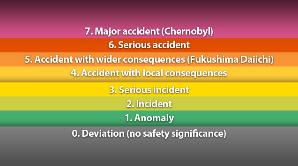
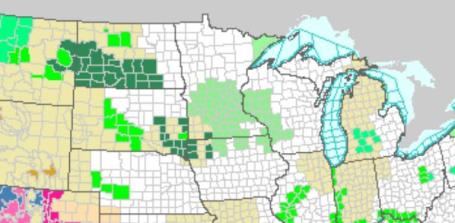



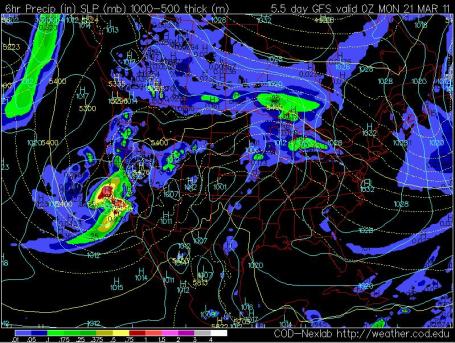
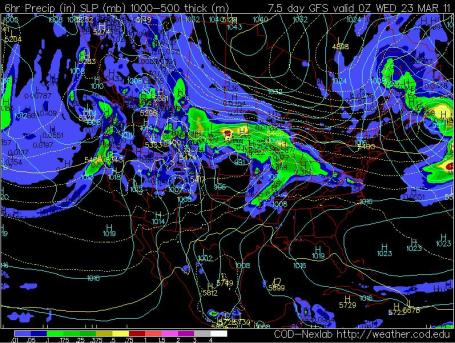

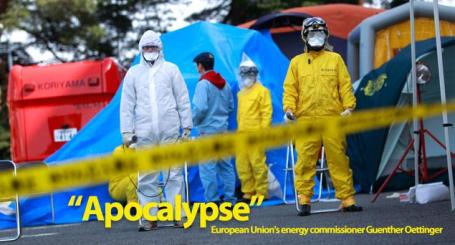
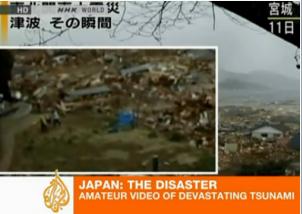
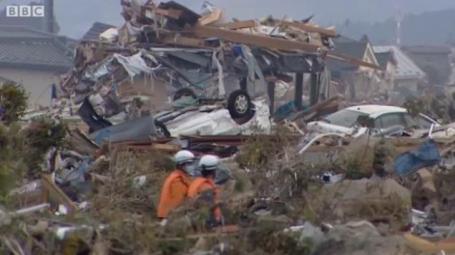

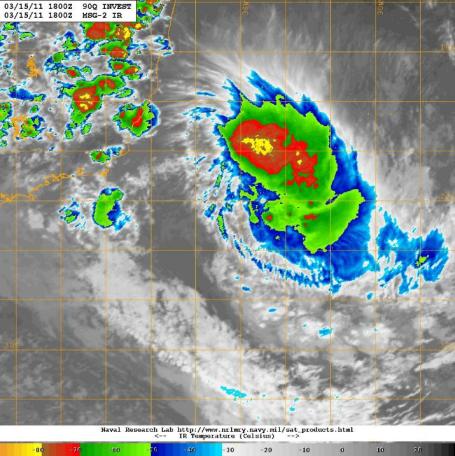











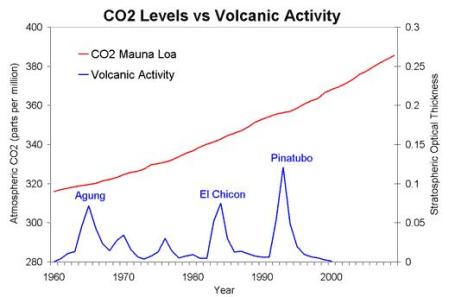


No comments:
Post a Comment